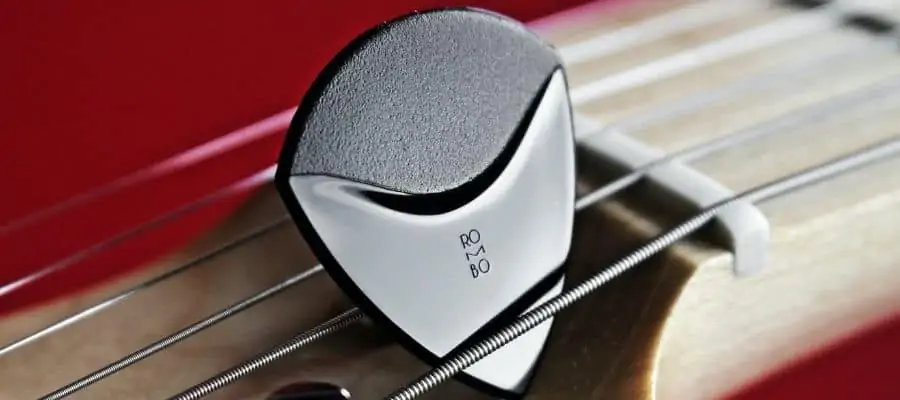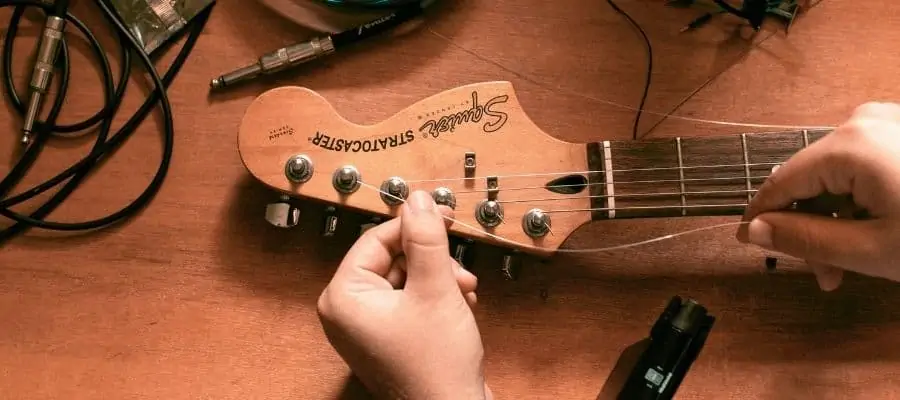Strings have been coiled up in a tiny package, and when you put them on a guitar, they are being stretched, so they go through an enormous change. That’s why when they go flat quickly.
So, How long does it take for new guitar strings to break in/settle? They need several sessions (days) of playing to be stable. The time depends on your daily playing habits, the guitar strings’ manufacturer, the string gauge size, and so on.
Therefore, new guitar strings won’t deliver correct sounds right after you put them on your guitar. But, there are a few tricks to do, to fasten the break-in process in order to save your practice session or performance.
Why Do New Guitar Strings Need Time To Settle?

As I said before, strings have been coiled up in a package, so when they stretch, they find themselves under some kind of stress. Guitar strings have some elastic properties, so if you tune a string, that will stretch it, and because of those elastic properties, guitar strings tend to go in a previous condition.
That’s why it takes time for them to adapt, and for a couple of days, your guitar might not sound the same even after you’ve tuned it.
Do New Guitar Strings Need To Be Broken In?

New guitar strings need to be broken in so that they can stay in tune and produce their best tone.
If you want the best possible guitar sound, don’t be disappointed if you don’t get what you want right after putting in new guitar strings. New guitar strings will be nearly impossible to keep in tune immediately after installation. The string material needs some amount of time to “settle in” to the amount of proper tension, so new guitar strings need to be broken in. The average tension that a guitar string is under is between sixty and eighty Newtons, which may not seem that much. But for a string diameter between .009 and .052, this is a significant amount of tension. So, it is necessary to break in to properly acclimate, therefore to keep in tune.
Also, so many players notice that new guitar strings sound brighter, and they describe it as “tinny” or “metallic”. Some of them do prefer this tone, while others don’t, and they want to break in the new strings on guitar as soon as possible.
How Long Does It Take For New Electric Guitar Strings To Settle?

Electric guitar strings are made of a steel core and winding, magnetically-active metal. It will take the least time for new electric guitar strings to settle. You need several playing sessions to make them stabilized, and the number of “several” depends on the guitar string brand, a string gauge size, your playing habits, and so on. By playing, I mean playing solos, bending the strings, and strumming the chords.
The break-in process can get faster with some methods that many guitarists use, and it will take up to 1-2 hours.
Break-in allows the guitar strings to stay in tune. But, that specific sound of new guitar strings won’t be away immediately; it will take 3-7 days for them to lose the “tinny” sound.
Of course, an electric guitar with a tremolo device locks the tuning into place, so constant tuning corrections are not necessary. Guitars without a locking device will need to be set up correctly.
How Much Time Do The Acoustic Guitar Strings Need To Settle?

Acoustic guitar strings are made of a steel core and winding, non-magnetically active metal. The acoustic and electric guitar strings’ structure is very similar, and that’s why they react similarly when it comes to breaking in and adjusting on a condition when not coiled up.
Therefore, it also takes some sessions of playing for acoustic guitar strings to settle. After a few days, they will also lose their specific tone described as bright and crisp. But, remember that lighter gauge strings will lose their tuning more quickly.
How Long Does It Take For Nylon Strings To Settle?

Nylon guitar strings are used on a classical guitar. Their structure is not similar to the structure of both acoustic and electric guitar strings. Nylon strings are made from nylon material, so they have more elastic features than steel guitar strings.
They may need constant tuning to keep them in tune and ready for playing. Nylon is more sensitive to temperature changes and humidity, which can affect the stability of nylon guitar strings.
Therefore, nylon strings on a classical guitar take the longest time to settle. The average time for these guitar strings to settle in 2-4 days. It depends on how many hours go into playing, the guitar’s construction, and the amount of stretching.
Besides longer time for these strings to stretch out, they also have a marked tendency to slip, especially if not tied properly. This also makes the guitar out of tune. So, it is possible to speed up the whole settling process by winding the strings correctly at the roller end, or maybe by trying out new strings with a reputation for settling in faster.
Many guitar players say that on the day of changing the strings, classical guitar is going to lose its tuning rapidly – within minutes!
How Do You Break In New Guitar Strings Fast?
Guitarists can be frustrated because of the guitar constantly being out of tune. Here are some hacks that can reduce the time needed to settle the new guitar strings. Some of them work better than others, and some are preferred by certain guitarists, while another player may prefer a different one or even none of the methods below.
Stretch By Pulling Above The Fretboard

This is the best way to fasten the break-in process. You can stretch new guitar strings with hands on the fretboard. Install the strings until they’re tight, and then stretch them manually and individually. Grab under the string, and use your thumbs as leverage against the fretboard, and then pull them up and away from the guitar.
It is important not to overdo it because you can break the strings, especially the upper ones (they need just 40 to 50 pounds of force to be broken). Therefore, do this slowly, but firmly.
Start with the low E string, bend the string at the 12th fret in a steady and slow motion, either away from the fretboard or toward the middle of the fretboard. Bend the string substantially. After stretching all of the strings manually, re-tune the guitar to the preferred tuning, and play the guitar. Repeat the whole stretching process once more.
Do these steps a few times, spend some time playing your guitar, and that’s enough to fasten the break-in process, so the new guitar strings don’t distort much when tuned to scale. The hew guitar string sound will take much more time to go away.
Stretch Near The Nut And Saddle

Besides stretching guitar strings manually, you may also consider pulling them near the guitar’s saddle and the nut. This is also a method of stabilizing new guitar strings quickly. Guitar strings “rest” at the nut, and it’s near the headstock of the guitar. Here you can use your finger on each side, and press down on a string to stretch it. Do it individually, carefully, and slowly.
The same process needs to be done at the saddle of the bridge, and it’s really effective to fasten the whole process of breaking in new guitar strings.
This is the best way to fasten the whole break-in process, just as pulling strings above the fretboard. You can do this method separately or may be combined with the manual stretching described above.
A Stable Over-Tuning

Another method is tuning brand-new strings up a half step higher and then letting them sit at that higher tension. Once they adapt to that level of tension, they will adhere to standard tuning faster.
First of all, install new guitar strings and tune them up one-half step higher than the tuning you plan to use on the guitar. After that, play the guitar for five minutes. It will be good if you play the guitar more aggressively. While playing, new guitar strings are not going to hold the tuning.
Then, re-tune the strings. Again, tune them up a half step higher, and play the guitar for five minutes. Re-tune once more, but this time, let the guitar sit without playing for at least 10-12 minutes.
After these steps, tune all guitar strings down to the tuning you plan to use. Keep in mind to tune down just a bit lower than the intended tone. That’s how you’re tuning the strings up to the preferred note and adding tension to the string.
In the end, play your guitar with your intended tuning, without using a more aggressive playing style. Re-tune if needed.
Play The Guitar

Playing the guitar for some hours, depending on the type of guitar strings, is an effective method (even if some players don’t classify it as a method) for a faster break-in process. No over-tuning, no stretching, just playing.
After installing the brand-new strings and tuning them to the preferred tuning, play the guitar with no special style. Use your ears to listen to the tone, and re-tune guitar strings that are out of tune. Continue the process.
By playing your guitar, you won’t just stabilize the guitar strings, you will get to know your instrument way better!
Boiling Guitar Strings

This trick is well-known in the music industry, and it’s used more by bass guitar players. But, acoustic guitar players and also electric guitar players use it as well. You can boil both old and new guitar strings. When you boil a guitar string, it causes the string to stretch and release oil and dirt (when boiling an old one). I don’t recommend this method, but it can be another option if you love experimenting (or maybe spending more time in the kitchen).
I will describe the boiling process of the new guitar strings. So, first of all, fill the saucepan with distilled water, and place it on your stove with the burner on high. Wait for the water to boil. Put coiled strings in the boiling water one at a time. Use tongs.
You boil guitar strings for 5 minutes sharp. If you go any longer, the strings may be destroyed. Bass guitar strings boil for 15 minutes sharp.
Remove the strings from the water using tongs, and put them on a towel ( not a paper one!), and dry strings with it. After that, preheat the oven to its lowest temperature, and put the foil-wrapped strings in the oven for 15 minutes. Two strings have to be wrapped together. Please perforate the foil with the fork several times. That will allow the air to circulate and dry the strings. After 15 minutes, put the strings out of the oven and let them cool. Then, put them on your guitar.
There are some risks when boiling the guitar strings. If you over-boil them, they can be more breakable and with no adequate tone.
Is Stretching Guitar Strings A Myth?

Many players use a stretching method for guitar strings to break in faster. But, is it really effective?
Guitar strings do stretch because of the applied force. In this case, the force is actually a tension that will make the strings stretch out a little bit. They don’t need a lot of time to hit the optimal point at which they are going to be stabilized and sound well. Sometimes they may need a couple of hours to settle, sometimes a few days.
To make the break-in process faster, manually stretching is one of the methods. And no, stretching guitar strings is not a myth; it’s such a helpful process!
Do Different Types Of Guitar Strings Take Different Time To Break-In?

Different types of guitar strings do take different times to break in. Some types break in faster, and some of them are a bit slower. As I said, steel guitar strings take about 1-2 hours of playing to be stable. Nylon strings take up to 2 days to stabilize.
But, different guitar strings manufacturers also show the difference in taking the time of the breaking-in process. Not all string sets settle in, in the same manner. Some of the brand variants settle in faster than others.
For example, some of the brands that are well-known for the fast settling process are D’Addario Titanium Trebles, Aquila Alabastro, La Bella 500P, and so on.
My advice is to test out different brands of strings. You should take notes about the results for the best choice in the future.
Which Factors Extend Break-In Time For New Guitar Strings?

Some factors have an impact on the length of the new strings breaking in the process. Some of them are neck relief, nut, angle of the headstock, saddle, string thickness, re-string techniques, bridge, and tuning pegs.
How many hours do you play the guitar is also one of the things that can extend guitar strings break-in time or not. If you play more, the break-in time will be shorter, and opposite.
Humidity and constant temperature changes are also important and can extend break-in time.
Is Changing Strings Before Gigs A Good Choice?

Some guitarists tend to change guitar strings right before the show, either because they don’t trust the old ones or they prefer new strings’ sound.
After installing new strings on the guitar, they stretch them. A lot! Also, they try to play the guitar before the beginning of the show to help strings settle and be perfect for the performance.
Some of the guitarists or bands hire a technician who does the whole stretching and settling process.
But, the choice about changing strings before gigs or not depends on the guitarist, how much he/she plays per day, and also how many gigs he/she has. The more playing/gigs, the more changing strings! (for some players on a weekly or daily basis)
So, yes. It is a good choice if you know how to fasten the break-in process in a proper way.
Conclusion
Guitar strings have some elastic properties, therefore they tend to go in a previous condition. So, when you put new strings on a guitar, they go through some changes. New guitar strings need to be broken in, because they go out of tune quickly, and they sound brighter. Some players describe the sound as “metallic” and “tinny”.
Both acoustic and electric guitar strings have a similar structure, therefore they need a similar time to break-in. They need several sessions (days) of playing to be stable. The time depends on your daily playing habits, the guitar strings’ manufacturer, the string gauge size, and so on. Constant temperature changes, humidity, and a guitar set-up can also extend or reduce the time needed for a proper guitar string break-in.
There are some methods for faster guitar strings settling. The best ways are manually stretching over the fretboard, and at the nut or saddle. There is also a stable over-tuning, playing the guitar, and so on. Also, you can buy new guitar strings from another manufacturer, because they can be faster to settle.
So, don’t be aware of being out of tune after changing the strings, if you know how to stretch them properly!
If you found this article useful you may want to save this pin below to your Guitar board

Recent Posts
Some guitarists insist on buying an expensive amplifier with their electric guitar. They assume that this is a must for every type of guitarist out there. However, in some situations, this isn’t...
Top 50 Free Realistic Guitar VST Plugins With Sound Examples
As technology has rapidly advanced in the recent decade, computers are stealing more and more roles from physical musical instruments and accessories. Nowadays, you do not need expensive amps,...

